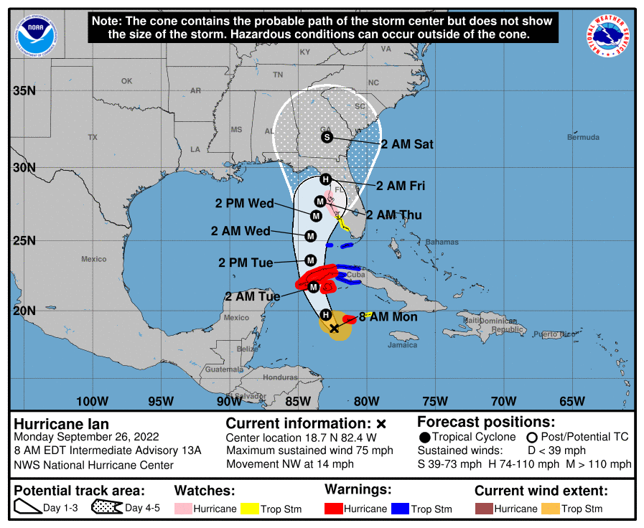It's that time of year again. For those of you in the path of Hurricane Ian, please note the following message from FEMA and the Heritage Emergency National Task Force (HENTF).
Key Messages from the National Hurricane Center at HURRICANE IAN (noaa.gov)
Ian is expected to produce heavy rainfall and instances of flash flooding and possible mudslides in areas of higher terrain, particularly over Jamaica and Cuba. Considerable flooding impacts are possible later this week in west central Florida. Additional flash and urban flooding, and flooding on rivers across the Florida Peninsula and parts of the Southeast cannot be ruled out for later this week.
Life-threatening storm surge and hurricane-force winds are expected in portions of western Cuba beginning late today, and Ian is forecast to be at major hurricane strength when it is near western Cuba. Efforts to protect life and property should be rushed to completion.
Ian is expected to be a major hurricane in the eastern Gulf of Mexico during the middle of this week. Regardless of Ian's exact track and intensity, there is a risk of a life-threatening storm surge, hurricane force winds, and heavy rainfall along the west coast of Florida and the Florida Panhandle by the middle of this week. Tropical Storm and Hurricane Watches have been issued for a portion of the west coast of Florida and additional watches may be required later today.

Key Messages from the Heritage Emergency National Task Force
The following content is also available as a Word document and a PDF at https://culturalrescue.si.edu/hentf/resources/federal-resources-cultural-stewards-and-emergency-managers/
It's important that all individuals and cultural institutions prepare for possible strong winds, heavy rain, and flooding:
- Track the storm via the National Hurricane Center, http://www.nhc.noaa.gov/.
- Monitor information via the Florida Division of Emergency Management, https://www.floridadisaster.org/info.
- Gather your staff and review your disaster plan today. No disaster plan? Put that at the top of the to-do list once the storm passes (and hope you didn't need it this time).
- If you have a disaster plan, make sure everyone has a printed copy to take home. An electronic version may be useless if you lose power.
- Make sure staff, volunteer, and board contact lists are up to date. Determine how you will communicate with one another before, during, and after the storm.
- Make sure your insurance and disaster recovery vendor contact information is readily available.
- If you don't already have up-to-date images (photographic/video) of your facility's exterior and interior, including storage areas, now's the time to take them. Being able to illustrate how your building and collections looked before damage will be helpful if the need arises to pursue recovery financing.
- Back up electronic records and store the back-ups off-site or in the cloud.
- Secure outdoor furniture, bike racks, book drops, etc. – anything that can become a projectile in strong winds.
- Move collections that are in areas vulnerable to flooding – i.e., the floor, the basement – or susceptible to rain – near windows or under roofs.
- If you have time, cut lengths of plastic sheeting to be able to throw them over shelves or equipment should the building envelope be compromised.
- Know the location and shut-off procedures for water, electricity, and gas.
- Review individual or family plans. You'll feel better attending to your organization knowing that your loved ones are safe.
- For tips on what to do before, during, and after a hurricane, go to https://www.ready.gov/hurricanes.
- Keep this 24/7 hotline number handy: 202.661.8068. The National Heritage Responders, a team of trained conservators and collections care professionals, are available 24/7 to provide advice.
- Download FEMA fact sheets "After the Flood: Advice for Salvaging Damaged Family Treasures" and "Salvaging Water-Damaged Family Valuables and Heirlooms," available at https://www.fema.gov/assistance/save-family-treasures.
- Familiarize yourself with the disaster declaration process in case one is declared for your state, https://www.fema.gov/disaster-declaration-process.
------------------------------
Heather Parks
Binghamton University Libraries
Head of Preservation and Conservation
hparks@binghamton.edu------------------------------